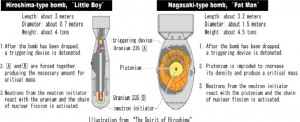Why was a uranium-type bomb used on Hiroshima and a plutonium-type bomb on Nagasaki?
Jul. 9, 2018
Two types were developed at the same time
The two bombs dropped on Hiroshima and Nagasaki are often referred to by their nicknames, "Little Boy" and "Fat Man." Photographs of these bombs show that the shapes of the two bombs were different: the Hiroshima bomb was thin while the Nagasaki bomb was plump.
Different nuclear materials
This difference in shape is due to the difference in the structure of these two bombs. Hiromi Hasai, Professor Emeritus of Hiroshima University, who has been involved in nuclear physics research for many years, offered the following explanation.
In the Hiroshima-type bomb, the uranium needed for nuclear fission is divided into two portions and placed at both ends of a long, narrow pipe. An explosive charge forces one part of this uranium to collide with the other, creating a chain of nuclear fission which generates enormous energy.
The Nagasaki-type bomb, though, places the plutonium at the bomb's center and surrounds it with explosives. These explosives exert pressure on the plutonium from all directions and this implosion generates the nuclear fission.
But why did the United States make two different types of atomic bombs at that time? Masakatsu Yamazaki, 63, Professor at Tokyo Institute of Technology and Shizue Hinogawa, 59, Professor at Takushoku University, co-authors of the book, "How the Atomic Bomb Was Developed," clarified the background.
The Nuclear Age began in 1938 when a German physicist discovered the phenomenon of nuclear fission. The news of this important discovery then quickly had a powerful impact on scientists all over the world.
However, this led to the idea of producing a bomb of mass destruction by exploiting the power of nuclear fission. At the time, people sensed that war might break out and so new weapons were being developed, particularly in England, which first imagined the atomic bomb.
In 1941, President Roosevelt of the United States learned of England's idea and charged a team of scientists with the task of creating the bomb. At that point, it was assumed that the bombs would contain uranium; although scientists felt plutonium was a viable material, too, its use was more technically advanced.
U.S. intensifies its efforts
In 1942, the U.S. government intensified its efforts on the "Manhattan Project" in order to produce the world's first atomic bomb. By this time, they had solved the technical challenges of using plutonium, too, and so the project now aimed to develop both types of bombs. In fact, the emphasis of their work shifted more towards developing the plutonium-type bomb.
For the uranium-type bomb, Uranium 235 is needed and substantial quantities of this naturally-occurring element are difficult to obtain. However, a large amount of plutonium can be readily produced by using a nuclear reactor. Consequently, by July 1945, America had completed three atomic bombs, two with plutonium and one with uranium.
Professor Hasai, an A-bomb survivor himself, added, "The scientist is naturally drawn to research that can advance new discoveries. And the military man, if he has a new weapon, will invariably use it. But such research, designed to destroy human beings, must not be pursued again." (Miho Kuwajima, staff writer)








